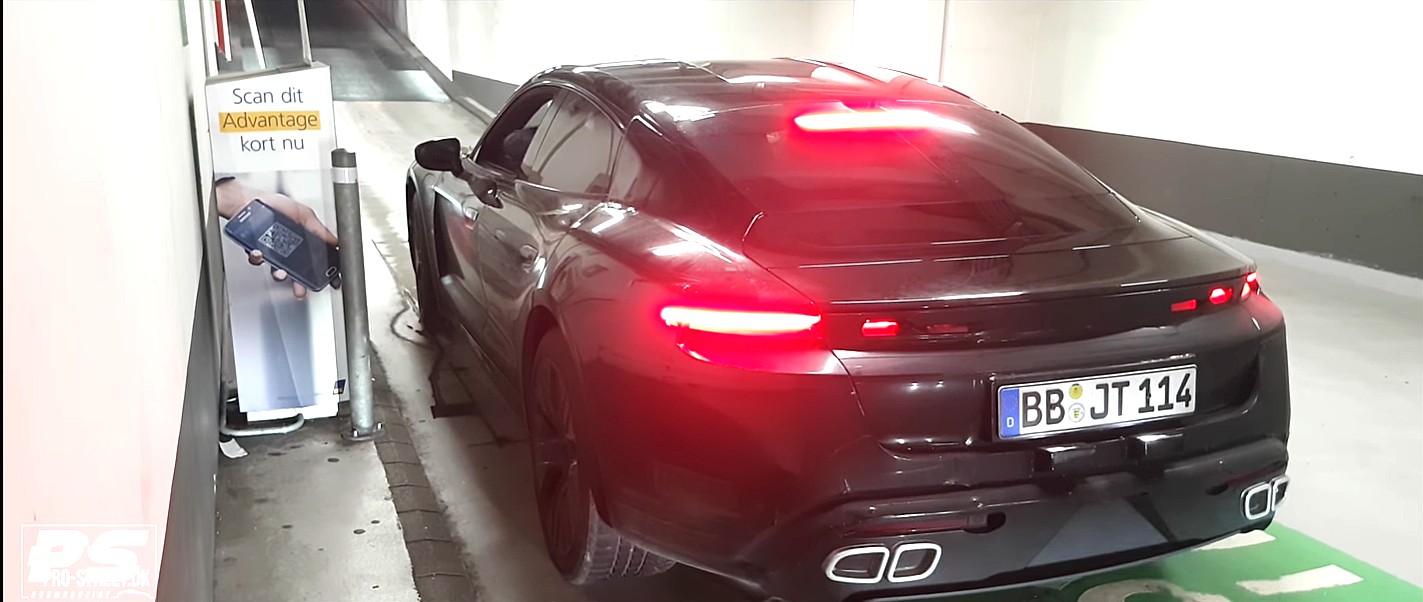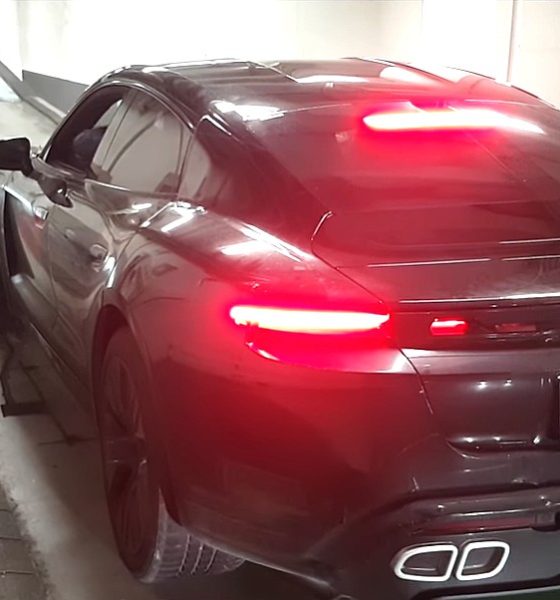

News
Porsche Taycan Turbo regen braking and sound details teased in first ride
The Porsche Taycan is nearing its official reveal, and the German carmaker is currently conducting the all-electric car’s final tests. As the vehicle’s last details get ironed out, auto publication CNET Roadshow was able to get an opportunity to ride shotgun in one of Porsche’s Taycan prototypes in Sweden, to experience the company’s next-generation vehicle firsthand.
The publication was able to take a ride in a test mule of the Taycan’s top-tier variant, a version speculated to be dubbed as the “Taycan Turbo.” Just as revealed in previous sightings, the Taycan Turbo boasts 600 horsepower with an all-wheel-drive powertrain that enables 0-60 mph times of
The Porsche Taycan will utilize a regenerative braking system that is quite different from those used by popular electric cars like the Tesla Model S, which engage their regen braking when the driver releases the accelerator. The Taycan does not do this, as the vehicle only coasts when the accelerator is released. The Taycan’s regenerative braking only happens when drivers press lightly on the brake pedal. When the brakes are pressed harder, the Taycan’s hydraulic brakes are engaged.
Bernd Propfe, director of the Taycan’s platform product line, described the process to the publication. “Coasting is the most energy-efficient way to do it, because braking always goes along with a loss of energy, because no engine has a 100 percent ratio. We strongly believe that the customer, if he wants to brake, he should hit the brake,” he said.
While such a strategy will make one pedal driving impossible with the Taycan, the vehicle’s regenerative braking process is distinctly on-brand. Porsche prides itself as a maker of drivers’ cars, and requiring its customers to actively use both the accelerator and brake pedal while operating the Taycan could be considered part of the all-electric sedan’s genuine driving experience.
Also unique in the Taycan is the vehicle’s two-speed transmission at the rear. Electric cars like the Model S utilize a single gear transmission, partly due to the power generated by the vehicle’s electric motors. Tesla attempted a two-speed transmission in the original Roadster back in 2008, only to abandon the design after the transmission units showed a tendency to self-destruct just a fraction into the all-electric sports car’s lifespan. If Porsche’s design with the Taycan is any indication, it appears that the German carmaker is confident that it can use a two-speed transmission for the all-electric four-door sedan without compromising anything.
Propfe proved quite secretive when it came to the Taycan’s sound, only stating that it will be digitally created and it will change depending on the specific mode of the all-electric car. The platform line director added that the Taycan’s sound is still very much in development. Fortunately, this sound was captured recently in a sighting of a Taycan test mule in Copenhagen, Denmark. While taking off on a parking lot ramp, the Taycan gave off a truly unique noise that invoked a mix between a traditional high-performance sports car and a spaceship.
The Taycan’s sound is best heard firsthand. Make sure to keep the volume up.
And here’s CNET Roadshow‘s segment on its first ride with the Taycan.

News
Tesla FSD fleet is nearing 7 billion total miles, including 2.5 billion city miles
As can be seen on Tesla’s official FSD webpage, vehicles equipped with the system have now navigated over 6.99 billion miles.

Tesla’s Full Self-Driving (Supervised) fleet is closing in on almost 7 billion total miles driven, as per data posted by the company on its official FSD webpage.
These figures hint at the massive scale of data fueling Tesla’s rapid FSD improvements, which have been quite notable as of late.
FSD mileage milestones
As can be seen on Tesla’s official FSD webpage, vehicles equipped with the system have now navigated over 6.99 billion miles. Tesla owner and avid FSD tester Whole Mars Catalog also shared a screenshot indicating that from the nearly 7 billion miles traveled by the FSD fleet, more than 2.5 billion miles were driven inside cities.
City miles are particularly valuable for complex urban scenarios like unprotected turns, pedestrian interactions, and traffic lights. This is also the difference-maker for FSD, as only complex solutions, such as Waymo’s self-driving taxis, operate similarly on inner-city streets. And even then, incidents such as the San Francisco blackouts have proven challenging for sensor-rich vehicles like Waymos.
Tesla’s data edge
Tesla has a number of advantages in the autonomous vehicle sector, one of which is the size of its fleet and the number of vehicles training FSD on real-world roads. Tesla’s nearly 7 billion FSD miles then allow the company to roll out updates that make its vehicles behave like they are being driven by experienced drivers, even if they are operating on their own.
So notable are Tesla’s improvements to FSD that NVIDIA Director of Robotics Jim Fan, after experiencing FSD v14, noted that the system is the first AI that passes what he described as a “Physical Turing Test.”
“Despite knowing exactly how robot learning works, I still find it magical watching the steering wheel turn by itself. First it feels surreal, next it becomes routine. Then, like the smartphone, taking it away actively hurts. This is how humanity gets rewired and glued to god-like technologies,” Fan wrote in a post on X.
News
Tesla starts showing how FSD will change lives in Europe
Local officials tested the system on narrow country roads and were impressed by FSD’s smooth, human-like driving, with some calling the service a game-changer for everyday life in areas that are far from urban centers.

Tesla has launched Europe’s first public shuttle service using Full Self-Driving (Supervised) in the rural Eifelkreis Bitburg-Prüm region of Germany, demonstrating how the technology can restore independence and mobility for people who struggle with limited transport options.
Local officials tested the system on narrow country roads and were impressed by FSD’s smooth, human-like driving, with some calling the service a game-changer for everyday life in areas that are far from urban centers.
Officials see real impact on rural residents
Arzfeld Mayor Johannes Kuhl and District Administrator Andreas Kruppert personally tested the Tesla shuttle service. This allowed them to see just how well FSD navigated winding lanes and rural roads confidently. Kruppert said, “Autonomous driving sounds like science fiction to many, but we simply see here that it works totally well in rural regions too.” Kuhl, for his part, also noted that FSD “feels like a very experienced driver.”
The pilot complements the area’s “Citizen Bus” program, which provides on-demand rides for elderly residents who can no longer drive themselves. Tesla Europe shared a video of a demonstration of the service, highlighting how FSD gives people their freedom back, even in places where public transport is not as prevalent.
What the Ministry for Economic Affairs and Transport says
Rhineland-Palatinate’s Minister Daniela Schmitt supported the project, praising the collaboration that made this “first of its kind in Europe” possible. As per the ministry, the rural rollout for the service shows FSD’s potential beyond major cities, and it delivers tangible benefits like grocery runs, doctor visits, and social connections for isolated residents.
“Reliable and flexible mobility is especially vital in rural areas. With the launch of a shuttle service using self-driving vehicles (FSD supervised) by Tesla in the Eifelkreis Bitburg-Prüm, an innovative pilot project is now getting underway that complements local community bus services. It is the first project of its kind in Europe.
“The result is a real gain for rural mobility: greater accessibility, more flexibility and tangible benefits for everyday life. A strong signal for innovation, cooperation and future-oriented mobility beyond urban centers,” the ministry wrote in a LinkedIn post.
News
Tesla China quietly posts Robotaxi-related job listing
Tesla China is currently seeking a Low Voltage Electrical Engineer to work on circuit board design for the company’s autonomous vehicles.

Tesla has posted a new job listing in Shanghai explicitly tied to its Robotaxi program, fueling speculation that the company is preparing to launch its dedicated autonomous ride-hailing service in China.
As noted in the listing, Tesla China is currently seeking a Low Voltage Electrical Engineer to work on circuit board design for the company’s autonomous vehicles.
Robotaxi-specific role
The listing, which was shared on social media platform X by industry watcher @tslaming, suggested that Tesla China is looking to fill the role urgently. The job listing itself specifically mentions that the person hired for the role will be working on the Low Voltage Hardware team, which would design the circuit boards that would serve as the nervous system of the Robotaxi.
Key tasks for the role, as indicated in the job listing, include collaboration with PCB layout, firmware, mechanical, program management, and validation teams, among other responsibilities. The role is based in Shanghai.
China Robotaxi launch
China represents a massive potential market for robotaxis, with its dense urban centers and supportive policies in select cities. Tesla has limited permission to roll out FSD in the country, though despite this, its vehicles have been hailed as among the best in the market when it comes to autonomous features. So far, at least, it appears that China supports Tesla’s FSD and Robotaxi rollout.
This was hinted at in November, when Tesla brought the Cybercab to the 8th China International Import Expo (CIIE) in Shanghai, marking the first time that the autonomous two-seater was brought to the Asia-Pacific region. The vehicle, despite not having a release date in China, received a significant amount of interest among the event’s attendees.








